14年 语言学
《语言学概论》历年自考真题
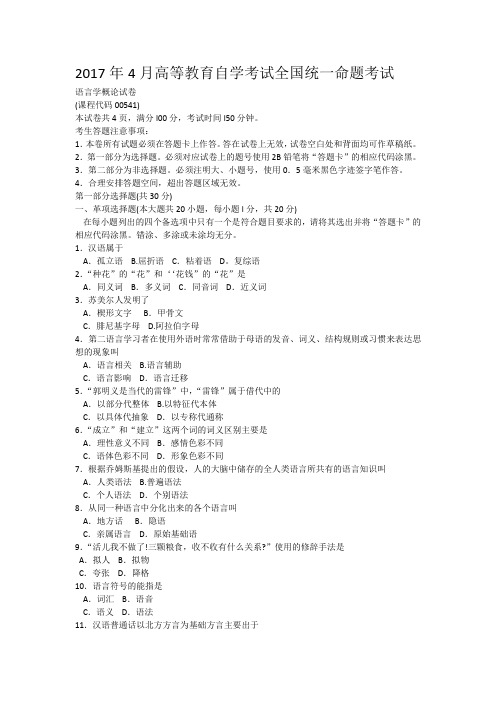
2017年4月高等教育自学考试全国统一命题考试语言学概论试卷(课程代码00541)本试卷共4页,满分l00分,考试时间l50分钟。
考生答题注意事项:1.本卷所有试题必须在答题卡上作答。
答在试卷上无效,试卷空白处和背面均可作草稿纸。
2.第一部分为选择题。
必须对应试卷上的题号使用2B铅笔将“答题卡”的相应代码涂黑。
3.第二部分为非选择题。
必须注明大、小题号,使用0.5毫米黑色字迹签字笔作答。
4.合理安排答题空间,超出答题区域无效。
第一部分选择题(共30分)一、革项选择题(本大题共20小题,每小题l分,共20分)在每小题列出的四个备选项中只有一个是符合题目要求的,请将其选出并将“答题卡”的相应代码涂黑。
错涂、多涂或未涂均无分。
1.汉语属于A.孤立语 B.屈折语C.粘着语D。
复综语2.“种花”的“花”和‘‘花钱”的“花”是A.同义词B.多义词C.同音词D.近义词3.苏美尔人发明了A.楔形文字B.甲骨文C.腓尼基字母 D.阿拉伯字母4.第二语言学习者在使用外语时常常借助于母语的发音、词义、结构规则或习惯来表达思想的现象叫A.语言相关 B.语言辅助C.语言影响D.语言迁移5.“郭明义是当代的雷锋”中,“雷锋”属于借代中的A.以部分代整体 B.以特征代本体C.以具体代抽象D.以专称代通称6.“成立”和“建立”这两个词的词义区别主要是A.理性意义不同B.感情色彩不同C.语体色彩不同D.形象色彩不同7.根据乔姆斯基提出的假设,人的大脑中储存的全人类语言所共有的语言知识叫A.人类语法 B.普遍语法C.个人语法D.个别语法8.从同一种语言中分化出来的各个语言叫A.地方话B.隐语C.亲属语言D.原始基础语9.“活儿我不做了!三颗粮食,收不收有什么关系?”使用的修辞手法是A.拟人B.拟物C.夸张D.降格10.语言符号的能指是A.词汇B.语音C.语义D.语法11.汉语普通话以北方方言为基础方言主要出于A.人们的喜好B.经济上的原因C.文化上的原因D.政治上的原因12.诗歌属于A.谈话语体B.应用语体C.文学语体D.宣传语体13.纳西族语言称“大树”为“树母”、“小树”为“树男”,反映出古代纳西族曾经历过A.群婚制阶段B.族外婚制阶段C.母系氏族社会阶段D.家族制阶段14.希腊字母属于A.辅音文字B.全音素文字C.表意文字D.象形文字15.古代关于马的词很多,如“驹”两岁马、“駣”三岁马、“馬八”八岁马,这些词被称为A.同源词B.类义词C.同义词D.同形词16.语言符号的结构必须是按照时间先后顺序依次出现,这是语言符号的A.系统特征B.约定特征C.层级特征D.线性特征17.对“语言”和“言语”这两个概念进行区分的是A.索绪尔B.鲍阿斯C.沃尔夫D.施莱歇尔18.“他们的品质是那样的纯洁和高尚,他们的意志是那样的坚韧和刚强,他们的气质是那村的纯朴和谦逊,他们的胸怀是那样的美丽和宽广”是A.对偶句B.排比句C.反复句D.回环句19.下面各词借自于汉代西域的是A.葡萄B.罗汉C.蛮夷D.胡同20.某一言语社团同时使用两种或两种以上语言的社会现象叫A.混合语现象B.惯用语现象C.克里奥尔现象D.双语现象二、多项选择题(本大题共5小题,每小题2分,共10分)在每小题歹|j出的五个备选项中至少有两个是符合题目要求的,请将其选出并将“答题卡”的相应代码涂黑。
中国影视翻译研究14年发展及现状分析
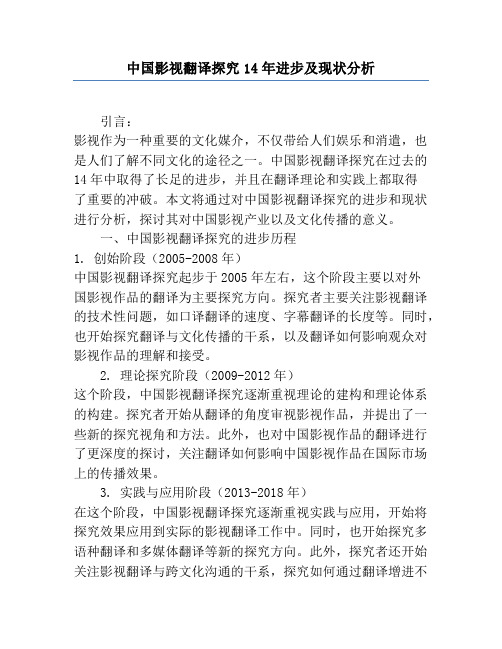
中国影视翻译探究14年进步及现状分析引言:影视作为一种重要的文化媒介,不仅带给人们娱乐和消遣,也是人们了解不同文化的途径之一。
中国影视翻译探究在过去的14年中取得了长足的进步,并且在翻译理论和实践上都取得了重要的冲破。
本文将通过对中国影视翻译探究的进步和现状进行分析,探讨其对中国影视产业以及文化传播的意义。
一、中国影视翻译探究的进步历程1. 创始阶段(2005-2008年)中国影视翻译探究起步于2005年左右,这个阶段主要以对外国影视作品的翻译为主要探究方向。
探究者主要关注影视翻译的技术性问题,如口译翻译的速度、字幕翻译的长度等。
同时,也开始探究翻译与文化传播的干系,以及翻译如何影响观众对影视作品的理解和接受。
2. 理论探究阶段(2009-2012年)这个阶段,中国影视翻译探究逐渐重视理论的建构和理论体系的构建。
探究者开始从翻译的角度审视影视作品,并提出了一些新的探究视角和方法。
此外,也对中国影视作品的翻译进行了更深度的探讨,关注翻译如何影响中国影视作品在国际市场上的传播效果。
3. 实践与应用阶段(2013-2018年)在这个阶段,中国影视翻译探究逐渐重视实践与应用,开始将探究效果应用到实际的影视翻译工作中。
同时,也开始探究多语种翻译和多媒体翻译等新的探究方向。
此外,探究者还开始关注影视翻译与跨文化沟通的干系,探究如何通过翻译增进不同文化之间的互相理解和沟通。
二、中国影视翻译探究的现状分析1. 探究效果丰硕经过14年的进步,中国影视翻译探究的效果丰富多样。
在翻译理论方面,中国影视翻译探究已经形成了一套系统的理论体系,包括翻译的语言学、文化学和交际学等方面的探究。
在翻译实践方面,探究者们所提出的理论和方法已经被广泛应用于实际的影视翻译工作中,并取得了良好的效果。
2. 创新思维与国际沟通中国影视翻译探究在创新思维方面取得了重要的冲破。
探究者们运用翻译理论与实践相结合的方法,乐观探究中国影视作品的国际传播之道,不息冲破语言和文化的障碍。
语言学概论历年试题及参考答案【最新版】

语言学概论历年试题及参考答案【最新版】语言学概论历年试题及参考答案一、单项选择题(本大题共26小题,每小题1分,共26分)在每小题列出的四个备选项中只有一个是符合题目要求的,请将其代码填写在题后的括号内。
错选、多选或未选均无分。
1.语言符号具有可变性的根本原因在于语言符号的( A )A.任意性B.强制性C.离散性D.线性2.音高取决于( B )A.发音体振动的振幅B.发音体振动的频率C.发音体振动的持续时间D.共鸣器的形状3.听觉上最自然、最容易分辨的最小语音单位是( D )A.音素B.音位C.音渡D.音节4.就词重音而言,不能用来区别意义的是( C)A.自由重音B.移动重音C.固定重音D.不固定重音5.北京话“慢”单念时读[man],但“慢慢儿”却有人读做[mai mar],前一音节的语流音变现象是( B )A.同化B.异化C.弱儿D.增音6.“奥林匹克运动会”这个词包含的语素数量是(C )A.2个B.3个C.4个D.7个7.英语“worker”中的“-er”是( A )A.构词语素B.构形语素C.虚词语素D.词根语素8.下列汉语词语中的“儿”不属于词根语素(实义语素)的是( D)A.健儿B.女儿C.少儿D.花儿9.整个语汇系统的核心和基础是( D )A.通用语汇B.常用语汇C.一般语汇D.基本语汇10.一般语汇(非基本语汇)最重要的来源是( C )A.古语词B.方言词C.新造词D.外来词11.词组的聚合关系分类是指把词组分成( A )A.向心词组和离心词组B.联合词组和偏正词组C.基本词组和特殊词组D.简单词组和复杂词组12.把句子分成“单句”和“复句”,这种分类是( D )A.句子的句型类B.句子的句式类C.句子的功能类D.句子的简繁类13.“吓唬”和“恐吓”在非理性意义上的主要差别是( C )A.语气意义不同B.感情色彩不同C.语体色彩不同D.形象色彩不同14.下列关于词的本义和基本义关系的表述中,正确的一项是( C )A.二者总是一致B.二者总是不一致C.基本义比本义更常用D.本义比基本义更常用15.下列各项词义引申中,采用比喻方式的一项是( D )A.“锁”本指一种器具,后引申指凭借这一器具的行为B.“兵”本指兵器,后引申指使用兵器的人C.“南瓜”本指一种植物,后引申指这种植物的果实D.“后台”本指舞台的后面,后引申指在背后操纵、支持的人或集团16.下列关于等义词的表述中,正确的一项是( A )A.等义词是理性意义和非理性意义都完全相同的词B.等义词一般都能够长期并存C.等义词在语言表达上有一定的积极意义D.同义词大多是等义词17.“老王说服了小李”中“老王”是行为的施事,“小李”是行为的受事,这种意义是( B )A.语汇意义B.语法意义C.语境意义D.蕴含意义18.从现有文字史的资料来看,最早出现的字符大多是( D )A.记号B.笔画C.音符D.意符19.世界上最早的表音文字是( B )A.元音文字B.辅音文字C.意音文字D.全音位文字20.语言成分的借用,最常见、最突出的是( A )A.词语的借用B.语音成分的借用C.词缀的借用D.语法结构的借用21.下列几种类型的社会方言中,具有排他性的是( B )A.行话B.黑话C.官腔D.贵族语言22.以下对“思维”的表述中,正确的一项是( A )A.思维既包括思维活动,也包括思维结果B.思维分为感性思维和抽象思维两类C.思维的形式就是概念、判断、推理D.思维必须以语言为工具23.人类开始制造工具这种行为意味着( B )A.人类已经产生了语言B.人类已经产生了思维C.人类已经同时产生了语言和思维D.人类既没有产生语言,也没有产生思维24.患“失语症”是因为( B )A.大脑左、右半球的单侧化功能发生了改变B.大脑左半球的某个部位受到了损伤C.大脑的语言获得机制出现了遗传性障碍D.在语言临界期以前没有接触语言环境25.主要解释某个词语所代表事物的概念知识的一类词典是( D )A.历史词典B.信息词典C.语言词典D.百科词典26.从翻译技术的平面看,机器翻译可以分为四个层级,从低到高的排序是( A )A.单词、句法、语义、语境B.单词、语义、语境、句法C.单词、句法、语境、语义D.单词、语义、句法、语境二、多项选择题(本大题共5小题,每小题2分,共10分)在每小题列出的五个备选项中有二个至五个是符合题目要求的,请将其代码填写在题后的括号内。
语言学:语言学概论必看题库知识点四

语言学:语言学概论必看题库知识点四1、单选关于社会方言的形成,下列说法不正确的一项是()A.社会方言大多是在语言的相互接触中形成的B.社会方言是随着社会的社群分化而产生的C.一种语言的内部有可能形成社会(江南博哥)方言D.一种方言的内部有可能形成社会方言正确答案:A2、问答题简答音位和音位变体的关系。
正确答案:音位是从具体音素中抽象概括出来的功能音类,音位变体则是音位在特定语音环境中的具体体现。
音位是用来概括反映一组音素的辨义作用的功能单位,音位变体则是音位在各种语音环境里的实际发音。
3、名词解释共时文字学和历时文字学正确答案:共时文字学研究某一时期的文字系统,如现代文字学、现代汉字学、古文字学等。
历时文字学从发展变化的角度研究文字的历时变化,例如文字发展史、汉字发展史等。
4、单选洋泾浜语和克里奥耳语属于语言的()A、语言的借用和吸收B、语言的转用C、语言的混合D、双语现象正确答案:C参考解析:在不同语言频繁接触的地区,来源于不同语言的成分可能混合在一起,产生了洋泾浜语和克里奥耳语。
母语化了的洋泾浜语就成了克里奥耳语。
5、名词解释中介语现象正确答案:中介语现象指在外语学习过程中,学习者建立的一种既不同于母语又不同于外语而只属于个人的语言系统。
6、单选一种语言中数量最少的是()A、音素B、音位C、语素D、音节正确答案:B7、问答题简要说明音质音位和非音质音位的区别?正确答案:音质音位是以音素为材料,通过音质的差别来起辨义作用的音位。
因为说话时产生的连续语流总占据一定的时间,音质单位在语音组合的线性序列中都各自占有一个时间段落。
所以音质音位又叫做“音段音位”。
而非音质音位是通过音高、音强、音长的差别来起辨义作用的音位,因为它所依附的并不局限于一个音段音位,而且常常依附在音段音位的组合序列上,因此非音质音位又叫做“超音段音位”。
8、单选下列各组词,吸收外来成分的手段存在不一致情况的一组是()A.丹麦挪威法兰西B.沙拉咖啡麦当劳C.卡车啤酒立邦漆D.香波克隆好莱坞正确答案:D9、单选从词的构造方式看,下列各项中属于复合词的是()A.木头B.念头C.苦头D.山头正确答案:D10、名词解释社会现象正确答案:指那些与人类共同体的一切活动--产生、存在和发展密切联系的现象。
西北大学文学院《617语言学概论》历年考研真题汇编

目 录2009年西北大学文学院617语言学概论考研真题2010年西北大学文学院617语言学概论考研真题2011年西北大学文学院617语言学概论考研真题2012年西北大学文学院617语言学概论考研真题2013年西北大学文学院617语言学概论考研真题2014年西北大学文学院617语言学概论考研真题2015年西北大学文学院617语言学概论考研真题2009年西北大学文学院617语言学概论考研真题科日名称:语言学概论科目代码:607适用专业:语音学及应用语言学、汉语言文字学共2页-落案答在耘蚯蔚诗暮裁―—-名词解释(每小题2分,共10分)i1、边音2、语法手段3、义素4、音节文字.5、耳语二、分析题(共95分)]、用国际音标给下列汉字注音〈例如;苏点七15分)I翎酬③讲®{象©fe2、、分析“加减号”途三个字中所包含的音素和音位〔1。
分)|||分析以下三列词语中“头”的区别:(10分)-来头石头山头看头木头烟头甜头砖头坟头4、、用层次分析法分析下列句子:(1。
分).f r j I'■■,'「.官.■二[;;、;.I'.),».j-r*戒:2,G•::';■,•■-•_•:.,•.■、•!.:t上二用各国政痔纷纷提出构建终身教育体系'建设学习型社会的目标*5、分析下列词蛆中补语与动伺利宾语之间的意义关系:(15分)(1)他踢完了球(2)他踢破了鞋⑶他嘛了6、辨析下列两组同义词:(10分)(1)父亲——爸爸(2)近来一近期7、分析下列歧义结构(15分)(1)看踢3的孩子⑵这个人谁都认识(3)小张扣道小高喜欢自己8、用义素分析法分析下列词语的意义:(10分)(])生日(2)寿辰(3)诞辰三、论述题(共45分)1、语言符号的系统性(15分)2、口语和书面语的异同及其关系.(15分):3、词汇的发展:0号分)2010年西北大学文学院617语言学概论考研真题西北大学2010年招收攻读硕士学位研究生试题科目名称:语言学概论科目代码:607适用专业:语言学及应用语言学、汉语言文字学 共2页 答案橘答在碰^上,答在本曜1 的誉案一嬴^一、名词解释(每小题2分,共10分)L 音位变体2.词3.借词4.地域方言5.历史比较法二、分析题(共95分)1.用国际育标治丁列汉字注音,(例如:苏盘s % "了 血 簸M (W 朝④对⑤时 y ---刊q 2分析"公如D 15 分)ft 「如%”这三个字中所包含商音案和音位(10分)3.分析说明以下三列词语中“化"的作用:(1。
英语专业语言学历年真题试卷汇编14_真题(含答案与解析)-交互
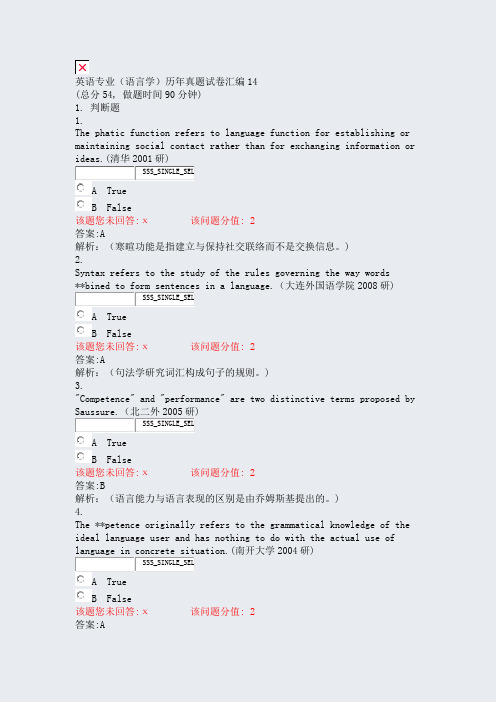
英语专业(语言学)历年真题试卷汇编14(总分54, 做题时间90分钟)1. 判断题1.The phatic function refers to language function for establishing or maintaining social contact rather than for exchanging information or ideas.(清华2001研)SSS_SINGLE_SELA TrueB False该题您未回答:х该问题分值: 2答案:A解析:(寒暄功能是指建立与保持社交联络而不是交换信息。
)2.Syntax refers to the study of the rules governing the way words**bined to form sentences in a language.(大连外国语学院2008研)SSS_SINGLE_SELA TrueB False该题您未回答:х该问题分值: 2答案:A解析:(句法学研究词汇构成句子的规则。
)3."Competence" and "performance" are two distinctive terms proposed by Saussure.(北二外2005研)SSS_SINGLE_SELA TrueB False该题您未回答:х该问题分值: 2答案:B解析:(语言能力与语言表现的区别是由乔姆斯基提出的。
)4.The **petence originally refers to the grammatical knowledge of the ideal language user and has nothing to do with the actual use of language in concrete situation.(南开大学2004研)SSS_SINGLE_SELA TrueB False该题您未回答:х该问题分值: 2答案:A解析:(语言能力与语言在具体情况下的应用无关,语言表现是语言在具体情况下的表现。
语言学练习答案
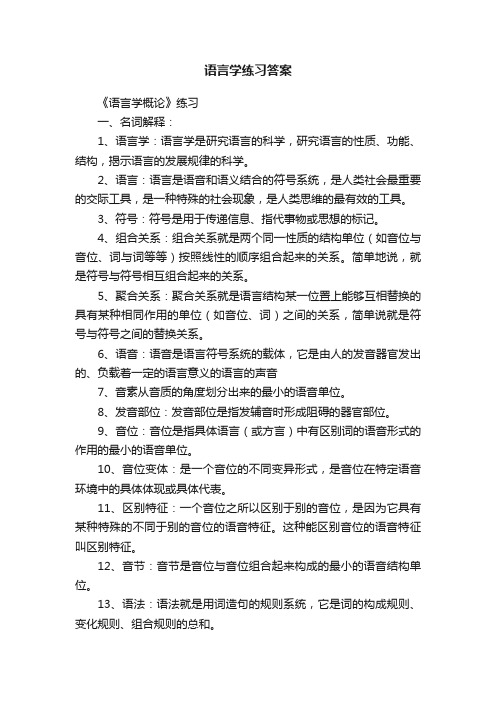
语言学练习答案《语言学概论》练习一、名词解释:1、语言学:语言学是研究语言的科学,研究语言的性质、功能、结构,揭示语言的发展规律的科学。
2、语言:语言是语音和语义结合的符号系统,是人类社会最重要的交际工具,是一种特殊的社会现象,是人类思维的最有效的工具。
3、符号:符号是用于传递信息、指代事物或思想的标记。
4、组合关系:组合关系就是两个同一性质的结构单位(如音位与音位、词与词等等)按照线性的顺序组合起来的关系。
简单地说,就是符号与符号相互组合起来的关系。
5、聚合关系:聚合关系就是语言结构某一位置上能够互相替换的具有某种相同作用的单位(如音位、词)之间的关系,简单说就是符号与符号之间的替换关系。
6、语音:语音是语言符号系统的载体,它是由人的发音器官发出的、负载着一定的语言意义的语言的声音7、音素从音质的角度划分出来的最小的语音单位。
8、发音部位:发音部位是指发辅音时形成阻碍的器官部位。
9、音位:音位是指具体语言(或方言)中有区别词的语音形式的作用的最小的语音单位。
10、音位变体:是一个音位的不同变异形式,是音位在特定语音环境中的具体体现或具体代表。
11、区别特征:一个音位之所以区别于别的音位,是因为它具有某种特殊的不同于别的音位的语音特征。
这种能区别音位的语音特征叫区别特征。
12、音节:音节是音位与音位组合起来构成的最小的语音结构单位。
13、语法:语法就是用词造句的规则系统,它是词的构成规则、变化规则、组合规则的总和。
14、句子:句子是交际中最基本的表述单位,是交流思想的基本语言单位。
15、词:词是造句的时候能够独立运用的最小单位;16、语素:语素是最小的语音语义结合体,语言的最小单位;17、变词语素:没有构词作用,但是能改变一个词的形式的语素,是变词语素,词尾就是变词语素。
18、构词语素:具有构词作用的语素就是构词语素,词根和词缀能参与构词,就是构词语素。
19、单纯词:是由一个词根语素构成的词。
例如汉语的“人、手、水、河、啊、琵琶、枇杷、哗啦、坦克”等,英语如man、teach、book、moon、sun、long 等都是单纯词。
语言学概论复习资料(全)
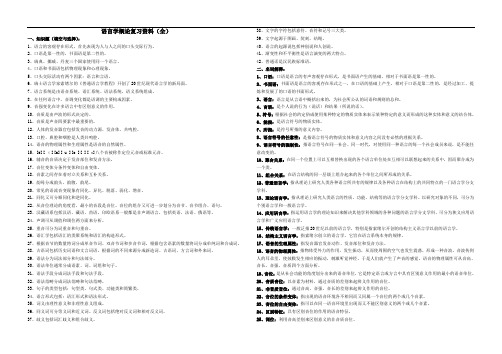
语言学概论复习资料(全)一、知识题(填空与选择):1、语言的客观存在形式,首先表现为人与人之间的口头交际行为。
2、口语是第一性的,书面语是第二性的。
3、瑞典、挪威、丹麦三个国家使用同一个语言。
4、口语和书面语包括物理现象和心理现象。
5、口头交际活动有两个因素:语言和言语。
6、瑞士语言学家索绪尔的《普通语言学教程》开创了20世纪现代语言学的新局面。
7、语言系统是由语音系统、语汇系统、语法系统、语义系统组成。
8、在任何语言中,音调变化都是语调的主要构成因素。
9、音强变化在许多语言中有区别意义的作用。
10、音质是由声波的形式决定的。
11、音质是声音四要素中最重要的。
12、人体的发音器官包括发音的动力源、发音体、共鸣腔。
13、口腔、鼻腔和咽腔是人类共鸣腔。
14、语音的物理属性和生理属性是语音的自然属性。
15、[e][ ε][a][ u ][o ][ ][ ɑ]八个音被称作定位元音或标准元音。
16、辅音的音质决定于发音部位和发音方法。
17、音位变体分条件变体和自由变体。
18、音素之间存在着对立关系和互补关系。
19、韵母分成韵头、韵腹、韵尾。
20、常见的语流音变现象有同化、异化、脱落、弱化、增音。
21、同化又可分顺同化和逆同化。
22、从音位理论的角度看,最小的音段是音位。
音位的组合又可进一步划分为音节、音节组合、语句。
23、汉藏语系包括汉语、藏语、苗语。
印欧语系一般都是非声调语言,包括英语、法语、俄语等。
24、声调可从调值和调位两方面来分析。
25、重音可分为词重音和句重音。
26、语汇学包括语汇的类聚系统和语汇的构造形式。
27、根据音节的数量将词分成单音节词、双音节词和多音节词。
根据包含语素的数量将词分成单纯词和合成词。
28、古语词包括历史词语和文言词语。
根据词的不同来源分成新造词、古语词、方言词和外来词。
29、语法分为词法部分和句法部分。
30、语法单位通常分成语素、词、词组和句子。
31、语法手段分成词法手段和句法手段。
语言学第四章课后答案

语言学第四章课后答案1、“桌子”,“书包”都属于名词,这体现了语法的什么性质()。
[单选题] *A.抽象性(正确答案)B.递归性C.系统性D.稳定性答案解析:“桌子”、“书包”等词语,虽然意思不同,但根据某种共同特点——大都能受数量词的修饰,就可以建立“名词”这个类:这就是词的用法对语法单位类别的抽象。
这体现了语法的抽象性。
2、语法规则的“系统性”是指()。
[单选题] *A.对语言的结构和成分进行类的概括B.相同规则可在一个结构里重复使用C.语法规则之间可以相互推导和解释(正确答案)D.语法规则的发展变化过程十分缓慢答案解析:所谓“系统”,指的是语法规则具有推导性和解释性。
3、“三思而后行”在今天读来依旧朗朗上口,体现了语法的什么性质()。
[单选题] *A.抽象性B.递归性C.系统性D.稳定性(正确答案)答案解析:“三思而后行”这句话产生在古代,现在依旧适用,体现语法的稳定性。
4、下列不属于共时语法的是()。
[单选题] *A.现代汉语语法B.先秦汉语语法C.汉语语法的演化(正确答案)D.近代汉语语法答案解析:共时语法指的是从某一时期存在的语法现象横向地静态地研究语法。
因此A、B、D选项都属于共时语法。
汉语语法的演化属于历时语法的体现。
5、以下关于“教学语法和信息语法”的内容说法有误的一项是()。
[单选题] *A.这是根据语法研究的用途区分的语法B.教学语法研究的结果面对的是人,或者说这种语法系统要充分考虑人的特点C.信息语法也叫“计算机语法”D.语法规则体系,方便计算机处理信息。
其特点是精确可靠,定义和规则具有可推导性和可开发性(正确答案)答案解析:教学语法和信息语法是根据语法研究的用途区分的语法。
教学语法研究的结果面对的是人,或者说这种语法系统要充分考虑人的特点;信息语法也叫“计算机语法”,其研究结果服务的是机器,即建立一套可以自动识别和操作的语法规则体系,方便计算机处理信息。
其特点是精确可靠,定义和规则具有可推导性和可验证性。
语言学第四章习题(含答案)
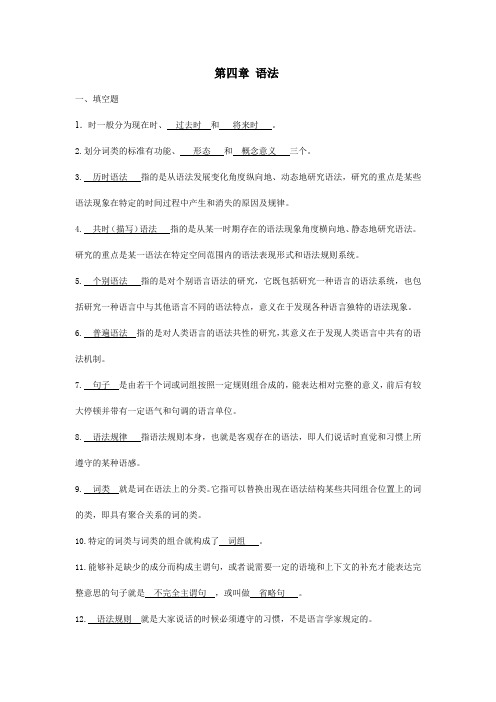
第四章语法一、填空题1.时一般分为现在时、过去时和将来时。
2.划分词类的标准有功能、形态和概念意义三个。
3. 历时语法指的是从语法发展变化角度纵向地、动态地研究语法,研究的重点是某些语法现象在特定的时间过程中产生和消失的原因及规律。
4. 共时(描写)语法指的是从某一时期存在的语法现象角度横向地、静态地研究语法。
研究的重点是某一语法在特定空间范围内的语法表现形式和语法规则系统。
5. 个别语法指的是对个别语言语法的研究,它既包括研究一种语言的语法系统,也包括研究一种语言中与其他语言不同的语法特点,意义在于发现各种语言独特的语法现象。
6. 普遍语法指的是对人类语言的语法共性的研究,其意义在于发现人类语言中共有的语法机制。
7. 句子是由若干个词或词组按照一定规则组合成的,能表达相对完整的意义,前后有较大停顿并带有一定语气和句调的语言单位。
8. 语法规律指语法规则本身,也就是客观存在的语法,即人们说话时直觉和习惯上所遵守的某种语感。
9. 词类就是词在语法上的分类。
它指可以替换出现在语法结构某些共同组合位置上的词的类,即具有聚合关系的词的类。
10.特定的词类与词类的组合就构成了词组。
11.能够补足缺少的成分而构成主谓句,或者说需要一定的语境和上下文的补充才能表达完整意思的句子就是不完全主谓句,或叫做省略句。
12. 语法规则就是大家说话的时候必须遵守的习惯,不是语言学家规定的。
13.语法的组合规则和聚合规则构成一种语言的语法规则。
14.从形式上看,句子的最大特点是有语调。
15.句子按其语气可以分为陈述句、疑问句、祈使句、感叹句等不同的类型。
例如“他取得了优异的成绩”是陈述句。
16.从是否能独立充当句法结构成分的角度看,词可以分为实词和虚词两大类。
17.语法研究通常以词为界,词以上的规则叫句法,词以下的规则叫词法。
18.我们可以根据语素在词中的不同作用把它分成构词语素和变词语素两类。
19.一个词,除去它的词尾,就是它的词干。
1504-全国-语言学概论
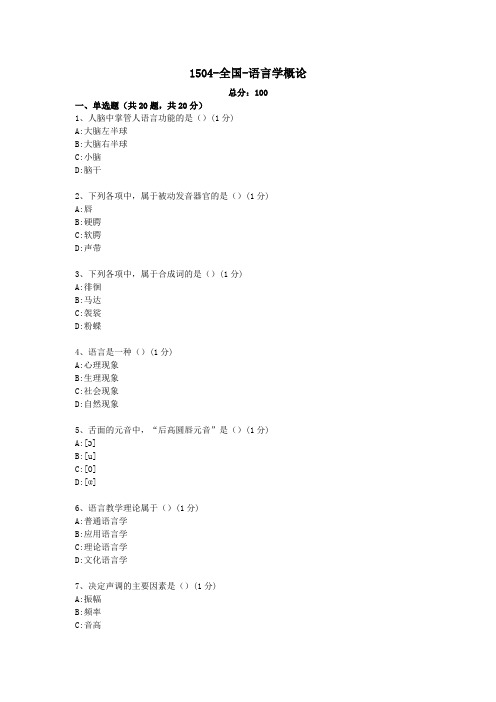
1504-全国-语言学概论总分:100一、单选题(共20题,共20分)1、人脑中掌管人语言功能的是()(1分)A:大脑左半球B:大脑右半球C:小脑D:脑干2、下列各项中,属于被动发音器官的是()(1分)A:唇B:硬腭C:软腭D:声带3、下列各项中,属于合成词的是()(1分)A:徘徊B:马达C:袈裟D:粉蝶4、语言是一种()(1分)A:心理现象B:生理现象C:社会现象D:自然现象5、舌面的元音中,“后高圆唇元音”是()(1分)A:[ᴐ]B:[u]C:[O]D:[œ]6、语言教学理论属于()(1分)A:普通语言学B:应用语言学C:理论语言学D:文化语言学7、决定声调的主要因素是()(1分)A:振幅B:频率C:音高D:陪音8、“上”“下”属于传统“六书”中的()(1分)A:象形B:指事C:会意D:形声9、“名无固宜,约之以命,约定俗成谓之宜,异于约谓之不宜”这句话出自()(1分) A:《墨子》B:《论语》C:《管子》D:《荀子》10、语言替换必然要经历()(1分)A:洋泾浜语阶段B:融合语阶段C:失语阶段D:双语阶段11、从现代汉语共时平面一词多义角度来看,“兵”的士兵义是它的()(1分)A:本义B:基本义C:象征义D:比喻义12、隐语是一种特殊的社会方言,其最突出的特征是()(1分)A:具有排他性B:一般不出声C:没有书写形式D:有特殊发音方式13、语言规范化的原则是()(1分)A:约定俗成B:国家制定标准C:权威机构认定D:自由发展14、“指南”“司机”都是()(1分)A:陈述式复合词B:偏正式复合词C:支配式复合词D:补充式复合词15、下列属于非主谓句的句子是()(1分)A:“有点红。
”B:“有人来了。
”C:“有些不舒服。
”D:“有两下子。
”16、方言分区主要依照的标准是()(1分)A:语法特点B:语义特点C:语汇特点D:语音特点17、汉语音节ya是一个()(1分)A:单韵母音节B:前响复元音C:后响复元音D:闭音节18、下列各项在现代汉语中属于不成词语素的是()(1分) A:企B:话C:地D:水19、克里奥尔语又叫做()(1分)A:皮钦语B:复综语C:混合语D:语言联盟20、造成“两个学校的老师”有歧义的原因是()(1分) A:语法结构歧义B:语义结构歧义C:语义指向歧义D:语义角色歧义二、多选题(共5题,共10分)21、下列各项中,属于印欧语系的语言有()(2分)A:意大利语B:法语C:丹麦语D:印地语E:捷克语22、下列各项中,属于汉语北京话/t/音位的变体有()(2分)A:[t]B:[t‘]C:[d]D:[d‘]E:[ʤ]23、导致社会方言产生的原因有()(2分)A:人群迁徙B:阶级分化C:性别D:文化程度E:宗教信仰24、下列各项中,属于重叠词的有()(2分)A:蝈蝈B:猩猩C:星星D:咚咚E:刚刚25、下列各项中,内部结构与“窗户”不同的有()(2分)A:房屋B:教室C:课桌D:开关E:钢笔三、判断论述题(共4题,共20分)26、汉字是一种音节文字。
福师14秋《语言学概论》在线作业二答案

福师14秋《语言学概论》在线作业二答案语言学概论福师《语言学概论》在线作业二一,单选题1.普通话中的“好”用国际音标记为()。
A。
[ hɑo ]B。
[ xɑu ]C。
[ hɑu ]D。
[ xɑo ]正确答案:B2.关于索绪尔的语言理论核心,下列说法不正确的是()A.“语言”和“言语”不同,语言学的对象是语言。
B.语言是一种符号系统,符号是由“能指”和“所指”结合而成的统一体。
C.语言符号系统中的一切要素都处在组合关系和聚合关系中。
D.语言学有共时语言学与历时语言学之分,历时比共时重要。
正确答案:D3.语音的本质属性是:A.生理属性B.物理属性C.心理属性D.社会属性正确答案:D4.借词“XXX(soda英)”的形成通过下面途径:A.音译B.音译加意译C.半音译半意译D.意译正确答案:A5.北京话“友好”中的“友”实际读音声调是XXX,这种现象属于语流音变中的( )。
A.同化B.异化C.弱化D.零落正确答案:B6.世界上的语种中使用人口最多的是:A.英语B.汉语C.俄语D.法语正确答案:B7.语言开展的内部原因是:A.社会生产力的开展,生产关系的改变,科学技术的开展B.不同社会的联系、交往、接触C.语言体系内部的各类身分相互关系、影响D.社会开展正确答案:C8.元音和辅音的本质区别在于:A.发音时气流是否受阻B.严重与否C.气流强弱D.舌位高低正确答案:A9.与“看片子”相同组合类型的短语是()。
A.看一本B.看一回C.看一次D.看一遍正确答案:A10.下列选项中属于偏正式的是:A.眼花B.酡颜C.地动D.雪白正确答案:D二,多选题1.词义的特点有:A.一般性B.模糊性C.全民性D.精确性正确答案:ABC2.语言发展的特点是:A.渐变性B.不平衡性C.稳定性D.平衡性正确答案:AB3.常见的词形变革:A.附加词尾B.内部屈折(语音交替)C.异根D.时正确答案:ABC4.历史上存在过和直到本日仍然存在的表意笔墨:A.古埃及的圣书字B.汉字C.中美洲的XXX文字D.我国纳西族的东巴笔墨正确答案:ABCD5.符号的种类很多,概括起来大致有三种:A.味觉符号B.听觉符号C.视觉符号D.触觉符号正确答案:BCD6.词语深层义的读解的方法有:A.依据语境考察词语深层的信息容量B.依据语境辨析词语表层义与深层义的反差C.依据语境欣赏寻常词语的内蕴乐趣D.依据语境揣摩人物形态心理正确答案:ABCD7.汉语大量吸收借词的两个历史时期:A.秦汉B.汉唐C.明代D.晚清到“五四”前后正确答案:BD8.汉语语音审美形态主要施展阐发在文学语言,具体施展阐发在以下方面:A.均衡美B.错落美C.顿挫美D.回环美正确答案:ABCD9.洋泾浜语的特点是:A.语法较为简朴B.划定规矩减少到最低限度C.语音也因受当地语言系统的影响而大走样D.词汇量也有限正确答案:ABCD10.笔墨开展的几种趋向:A.体系完善化的趋向B.构形符号化的趋向C.笔画简便化的趋向D.体制的表音化趋向正确答案:ABCD11.表意文字的特点:A.字量多B.字形有表示意思的结构成分C.字的笔画比较复杂D.管音节或语素表达的意义如何,相同的音节或音素(位),用同一的符号来书写?正确答案:ABC12.变换常使用的手段:A.移位B.增加C.删减D.替代正确答案:ABCD13.地域方言是同一个民族语言里的地域分支,它的形成有三个具体原因:A.地理条件B.社会政治经济历史等因素C.语言系统内部的变化D.社会内部不同年岁、性别、职业、阶级、阶层的人们在语言使用上施展阐发出来的一些变异?正确答案:ABC14.词语的特殊组合有:A.转义组合B.反义组合C.歧义组合D.变形组合正确答案:ABCD15.人类语言和所谓植物“语言”的区别:A.人类语言具有单位明晰性特点B.人类语言的音义结合具有任意性特点C.人类语言是一种开放体系D.人类语言具有布局的二层性正确答案:ABCD16.汉语语法的主要特点:A.语序的变革对语法布局和语法意义起严重影响B.实词的应用对语法布局和语法意义有重要作用C.汉语词类跟句法成份之间不存在简单的-一对应的关系D.短语的结构与句子的结构以及词的结构基本一致正确答案:ABCD17.名词的语法范畴:A.体B.性C.数D.格正确答案:BCD18.作为语言符号与其他符号的不同,主要有两点:A.随意约定B.这些符号都不是孤立存在的,而是与其他符号相对地存在C.复杂性D.XXX成性正确答案:CD19.语言符号在使用过程中带有:A.任意性B.强制性C.稳定性D.可变性正确答案:CD20.语法的特性:A.抽象性B.生成性C.稳固性D.民族性与普遍性正确答案:ABCD21.语音演变的规律性有几个明显的特点:A.条件性B.工夫性C.地区性D.随意性正确答案:ABC22.词语搭配的语义前提主要施展阐发在以下几个方面:A.受到现实现象之间实际关系的制约B.受到语义系列中其他成员的限制C.要考虑到社会使用惯的制约D.完全按照理性来判断正确答案:ABC三,判断题1.国际音标大多采用希腊字母,不够用又补充采用拉丁字母。
北京大学2014年硕士研究生入学考试试题
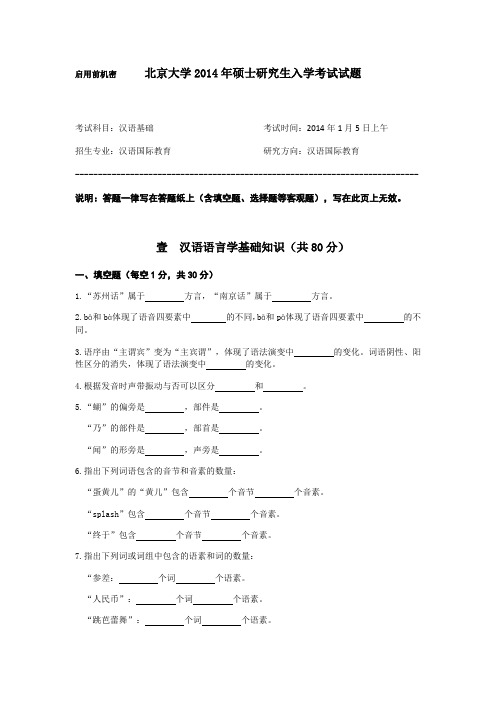
启用前机密北京大学2014年硕士研究生入学考试试题考试科目:汉语基础考试时间:2014年1月5日上午招生专业:汉语国际教育研究方向:汉语国际教育---------------------------------------------------------------------------说明:答题一律写在答题纸上(含填空题、选择题等客观题),写在此页上无效。
壹汉语语言学基础知识(共80分)一、填空题(每空1分,共30分)1.“苏州话”属于方言,“南京话”属于方言。
2.bā和bà体现了语音四要素中的不同,bā和pā体现了语音四要素中的不同。
3.语序由“主谓宾”变为“主宾谓”,体现了语法演变中的变化。
词语阴性、阳性区分的消失,体现了语法演变中的变化。
4.根据发音时声带振动与否可以区分和。
5.“蝴”的偏旁是,部件是。
“乃”的部件是,部首是。
“闻”的形旁是,声旁是。
6.指出下列词语包含的音节和音素的数量:“蛋黄儿”的“黄儿”包含个音节个音素。
“splash”包含个音节个音素。
“终于”包含个音节个音素。
7.指出下列词或词组中包含的语素和词的数量:“参差:个词个语素。
“人民币”:个词个语素。
“跳芭蕾舞”:个词个语素。
8.写出下列各词的国际音标:灰值京科二、判断题(每小题1分,共20分)1.“江”原义指长江,现在泛指较大的河流。
这种现象属于词义的转移。
2.音节是听觉上自然感到的最小的语音单位。
3.小篆是秦始皇统一六国后整理、推行的标准字体。
4.汉语拼音既可以拼写普通话也可以拼写方言。
5.零声母音节在实际发音时,开头往往带有轻微的喉塞或摩擦成分。
6.蒙古语属于印欧语系。
7.“iong”属于齐齿呼。
8.词语搭配要受到语法规则和语义条件的限制,同时社会使用习惯也会对词语搭配产生影响。
9.“去”在普通话中是去声字,在吴方言中同样也是去声字。
10.部件是合体字的结构单位,它大于笔画而小于独体字。
11.词法研究主要是以词为单位。
2014年华东理工大学英语语言文学一考研真题解析、参考书、考试科目、复试线、考试大纲
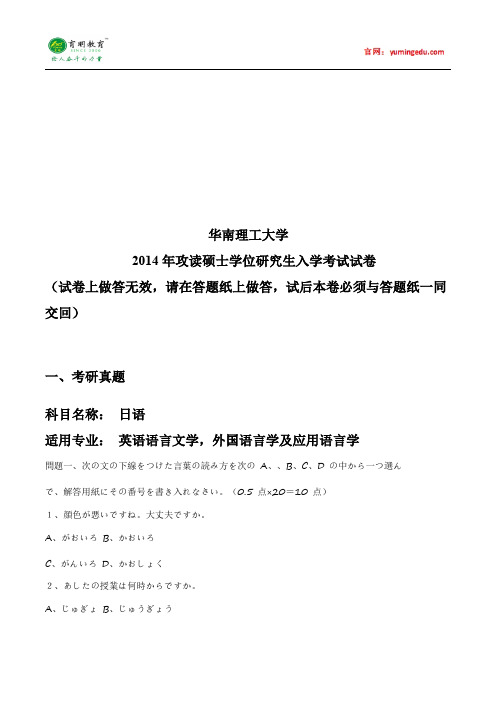
A、見るばかりで B、見るばかりしないで C、見てばかりしないで D、見ているばかりしないで 5、さっき冷蔵庫に入れて___ジュースはもう冷えているかな。 A、ある B、いる C、しまった D、おいた 6、どんなに大きい地震が___、この建物は壊れないでしょう。。 A、起きても B、起きてしまって 第 6 页 C、起きたら D、起きてみても 7、あの人は___すぎて、ちょっとうるさい時もあります。 A、親切で B、親切な C、親切に D、親切 8、君は__たびに、美しくなるね。 A、会う B、会って C、会った D、会える 9、店長、すみませんが、明日、___いただけないでしょうか。 A、休んで B、休めて C、休まれて D、休ませて 10、「ここに駐車してもいいですか。」 「すみませんが、ここは駐車してはいけない___。」 A、ことにします B、ことにしています C、ことになります D、ことになっています 11、若いとき___のに、年を取ってから、弱くなりました。 A、元気な B、元気だった C、元気 D、元気ない 12、「窓を開けましょうか。」「いいえ、その___でいいです。」 A、場合 B、はず C、ほう D、まま 13、庭の花がきれい___写真をとりましょう。
15、その看護婦さんはわたしの母___似ています。 A、で B、に C、と D、が 16、全部食べました。もうなに___ありません。 A、が B、は C、か D、も 17、会社___休んで、旅行に行きましょう。 A、を B、に C、で D、が 18、果物なら何___好きです。 A、も B、でも C、にも D、が 19、彼はいつ帰る___知っていますか。 A、が B、を C、も D、か 20、降りるとき、足元___気を付けてください。 A、の B、が C、に D、で 問題五、読解 読解文Ⅰ 次の文を読んで、(ア)~(エ)に何を入れるかを考えて、下の1、2、3、4か ら一番いいものを一つ選びなさい。(2 点×4=8 点) 山中さんと大山さんは同じ会社で働いています。 今日の仕事が終わって会社を出 ました。 山中「大山さん、(ア)。」 大山「そうですね。じゃ、いまから映画を見ませんか。」 山中「(イ)。」 大山「山中さんは(ウ)。」 山中「面白くて楽しいのを見ます。」 大山「じゃあ、あの映画を見ましょう。」 山中「そうしましょう。」 大山「(エ)近くのレストランでご飯を食べませんか。」
2014年10月《语言学概论》自考真题及答案
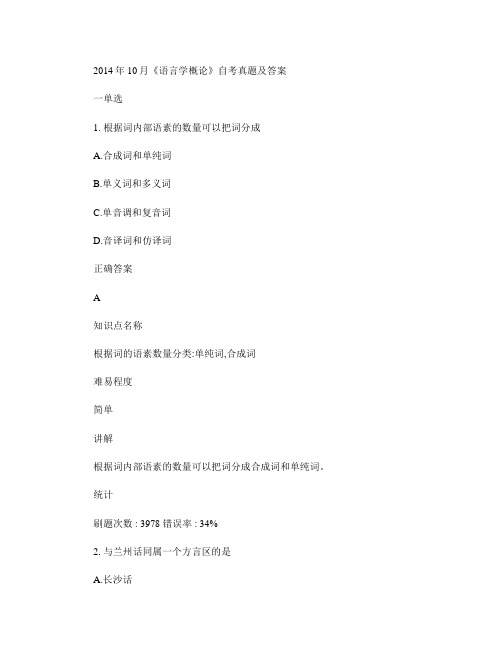
刷题次数: 2754错误率: 94%
22.下列各词中属于仿译词的有
A.足球
B.黑板
C.沙发
D.激光
E.蜜月
正确答案
A;B;E
知识点名称
仿译词
难易程度
一般
讲解
仿译词是用本族语言的语素逐个对译外语原词的语素造成的词,这种词不仅把原词的词义翻译过来,而且保持了原词的内部构成方式。例如,汉语中的"黑板"(131ackboard、"足球"({Football、"马力"(}lorsepower、"蜜月"(}loneymoon、"热狗"(hot dog、"超级市场"(supermal:ket、"黑马"(dark horse、"黑匣子"(1~laekbox、"软件"(soft—ware等就都是这种仿译词。
统计
刷题次数: 4386错误率: 24%
9.下列的词中属于古语词的是
A.过去
B.番茄
C.囹圄
D.苍白
正确答案
C
知识点名称
古语词的定义和分类
难易程度
简单
讲解
古语词与新造词相反,是指古代就已经产生,但又不算基本语汇,现在只是偶尔还使用的词,所以也是一般语汇的一部分。古语词又包括两小类:一类是"历史词语".如汉语"鼎、皇帝、状元、格格"等。现实生活中已不再用了,但在文献资料中还会碰到。另一类是"文言词语".如"余(我、足(脚、观(看、俸禄(工资、囹圄(监狱等。
统计
刷题次数: 3621错误率: 21%
6.下列各项中有歧义的是
语言学概论第一讲技术介绍

(三)语法的发展
• 第一,双音词的发展。 • 第二,词尾的发展。 • 第三,量词的发展。 • 第四,使成式的发展。
第一,双音词的发展
• 北京话“眼”发展为“眼睛”,“角”发 展为“犄角” 。
• “火车”、“轮船”、“电灯”、“电话”、 “火柴”、“肥皂”
第二,词尾的发展。
• 名词词尾“子”“儿”,人称代词词尾 “们”,形容词词尾“的”,副词词尾 “地”,动词词尾“了”“着”“过”, 都是近代产生的。
• 如果说全世界的语言有一个通天塔的 话,那么它应该在里海南岸。 ——复旦大学李辉、陶寰
•17
• 这一论断来源于复旦大学学者的最 新研究。美国《科学》杂志刊登了 他们的论文。
• 有趣的是,这个研究结果与圣经中传 说的“通天塔”的位置不谋而合。
• 用计算机来分析语言“基因”
这一研究是由复旦大学现代人类学教育部 重点实验室李辉教授课题组与中文系副教 授陶寰合作完成的。历时14年,他们分析 了全世界95个语系的579种语言资料,虽然 没有得到任何的经费支持。
3.拟象说:拟象说不同于拟声说,它将语 言的起源归因于对自然物象而非声音的模 拟。 • 口腔手势说
• 口型拟象说
• 陈澧在《东塾读书记·小学》中讲到:“盖 天下之象,人目见之则心有意,意欲达之 则口有声。意者,象乎事物而构之者也; 声者,象乎意而宣之者也。……如‘大’字 之声大,‘小’字之声小,‘长’字之声 长,‘短’字之声短。”
二、语言的分类问题
• 虽然巴别塔的故事只是一个传说,但也在某 种程度上反映了人类社会存在众多不同 语 言的事实。但当今世界上到底有多少种 语 言?这些不同的语言可以进行分类吗?如果可 以的话,分类的依据又是什么?
语言的谱系分类
语言学重点试题及答案
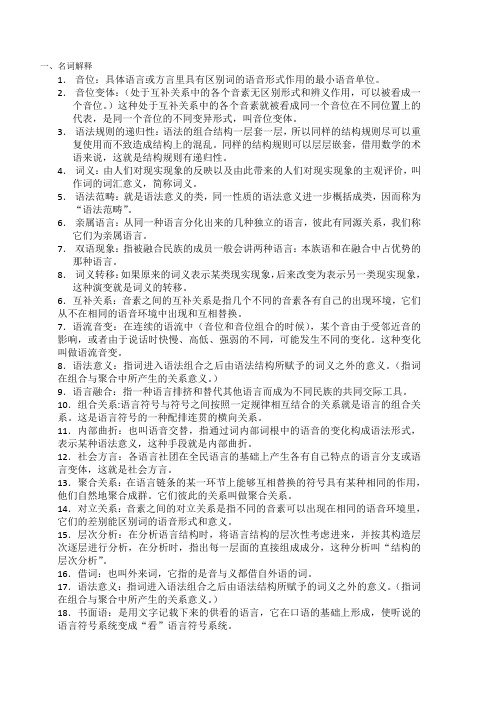
一、名词解释1.音位:具体语言或方言里具有区别词的语音形式作用的最小语音单位。
2.音位变体:(处于互补关系中的各个音素无区别形式和辨义作用,可以被看成一个音位。
)这种处于互补关系中的各个音素就被看成同一个音位在不同位置上的代表,是同一个音位的不同变异形式,叫音位变体。
3.语法规则的递归性:语法的组合结构一层套一层,所以同样的结构规则尽可以重复使用而不致造成结构上的混乱。
同样的结构规则可以层层嵌套,借用数学的术语来说,这就是结构规则有递归性。
4.词义:由人们对现实现象的反映以及由此带来的人们对现实现象的主观评价,叫作词的词汇意义,简称词义。
5.语法范畴:就是语法意义的类,同一性质的语法意义进一步概括成类,因而称为“语法范畴”。
6.亲属语言:从同一种语言分化出来的几种独立的语言,彼此有同源关系,我们称它们为亲属语言。
7.双语现象:指被融合民族的成员一般会讲两种语言:本族语和在融合中占优势的那种语言。
8.词义转移:如果原来的词义表示某类现实现象,后来改变为表示另一类现实现象,这种演变就是词义的转移。
6.互补关系:音素之间的互补关系是指几个不同的音素各有自己的出现环境,它们从不在相同的语音环境中出现和互相替换。
7.语流音变:在连续的语流中(音位和音位组合的时候),某个音由于受邻近音的影响,或者由于说话时快慢、高低、强弱的不同,可能发生不同的变化。
这种变化叫做语流音变。
8.语法意义:指词进入语法组合之后由语法结构所赋予的词义之外的意义。
(指词在组合与聚合中所产生的关系意义。
)9.语言融合:指一种语言排挤和替代其他语言而成为不同民族的共同交际工具。
10.组合关系:语言符号与符号之间按照一定规律相互结合的关系就是语言的组合关系。
这是语言符号的一种配排连贯的横向关系。
11.内部曲折:也叫语音交替,指通过词内部词根中的语音的变化构成语法形式,表示某种语法意义,这种手段就是内部曲折。
12.社会方言:各语言社团在全民语言的基础上产生各有自己特点的语言分支或语言变体,这就是社会方言。
2014年语言学概论阶段测评综合测试 试题(单选多选)
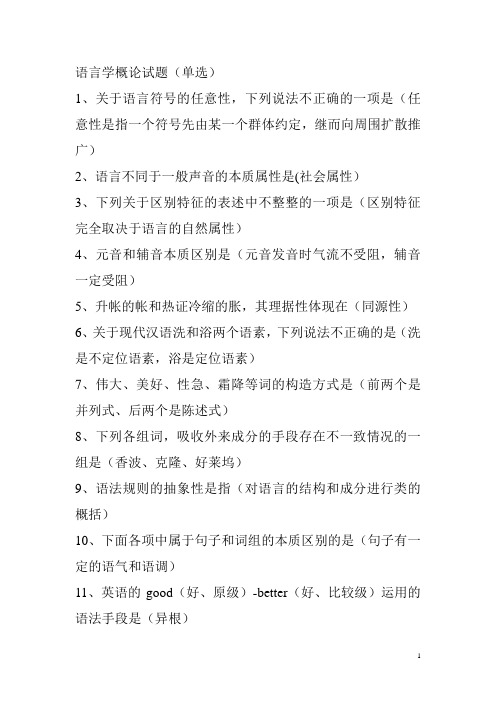
语言学概论试题(单选)1、关于语言符号的任意性,下列说法不正确的一项是(任意性是指一个符号先由某一个群体约定,继而向周围扩散推广)2、语言不同于一般声音的本质属性是(社会属性)3、下列关于区别特征的表述中不整整的一项是(区别特征完全取决于语言的自然属性)4、元音和辅音本质区别是(元音发音时气流不受阻,辅音一定受阻)5、升帐的帐和热证冷缩的胀,其理据性体现在(同源性)6、关于现代汉语洗和浴两个语素,下列说法不正确的是(洗是不定位语素,浴是定位语素)7、伟大、美好、性急、霜降等词的构造方式是(前两个是并列式、后两个是陈述式)8、下列各组词,吸收外来成分的手段存在不一致情况的一组是(香波、克隆、好莱坞)9、语法规则的抽象性是指(对语言的结构和成分进行类的概括)10、下面各项中属于句子和词组的本质区别的是(句子有一定的语气和语调)11、英语的good(好、原级)-better(好、比较级)运用的语法手段是(异根)12、下列关于组合规则,聚合规则的表述不正确的是(组合规则、聚合规则各自独立)13、下列关于语义模糊性的表述不正确的一项是(模糊性影响了人们的交际,所以要多造一些专有名词)14、下列关于义项的表述,正确的一项是(义项是词典、释义的最小单位)15、汉语同义词枯萎和干巴的主要差别是(具有不同的形象色彩)16、下列各项中,甲和乙是预设关系的一项是((甲)他不再偷钱了//(乙)他以前偷过钱)17、关于自源文字,下列表述不正确的一项是(都是语素文字)18、人类几种古老文字的原始字形都是(象形的)19、下列文字改革事项中,属于整个文字的类型不变,但字符的类型改变的是(1928年土耳其进行的文字改革)20、语言的发展演变是不平衡的,变化最慢的是(语法)21、方言之间的差别主要体现在(语音差别)22、洋泾滨语和克里奥尔语属于语言的(语言的混合)23、下列关于语言和思维的说法中,正确的是(思维先于语言发生)24、能够正确使用虚词和掌握形态变化是儿童获得语言的(复杂句阶段)1、[u]是(后高圆唇音)2、普通语言学主要探讨(人类语言的一般理论)3、索绪尔严格区分语言和言语的主要目的是(纯化语言学的研究对象)4、汉语普通话中的轻声主要与(音强有关)5、发音的动力源是(肺)6、[e]是(前半高元音)7、后低不圆唇元音是([a])8、汉语普通话中面貌连读属于(逆同化)9、利用发音的长短来区别意义的音位叫(时位)10、下面对中介语的表述正确的是(中介语只属于个人的语言系统)11、从语言信息处理技术本身来看,下列各项中属于未来一段时间研究的主攻方向的是(机器翻译)12、振动中频率最低的振动音叫(基因)13、索绪尔创立的语言学被称为(结构主义语言学)14、最小的交际单位是(句子)15、汉语中脑袋连读这种现象属于(弱化)16、汉语普通话通过音质的差别起区别的意义作用的有/k/和/k‘/17、关于语言,下列说法不正确的是(语言就是人和人之间交际时说出来的具体的话)18、20世纪语言学在索绪尔语言理论的影像下集中精力研究的是(语言系统本身的内在规律)19、下列说法正确的是语言和(种族无必然联系)20、具有均质性,抽象性的是(语言)21、语音的本质属性是它的(社会属性)22、下列语素中的自由语素是(人)23、下列词中不属于合成词的是(香槟)24、(异根)是一种词法手段25、汉语普通话中的卡通片里的卡是一个(音节)26、由词的语法形式所反映的事物在数量上的特征用语法学术语来表示叫(数)27、下列画线的部分是前缀的有(老师)28、汉语的黑板是一个(复合词)29、词和语素的主要区别在于(能否独立运用)30、下列各词属于汉语古词语的是(尚且)31、辅助词属于(虚词)32、下列单位,属于词组的是(高台)33、这句话第一层的正确的切分是(我/懂得应该怎样对付那一帮家伙)34、教学语法的特点是(规范性)35、我的书是一个(偏正词组)36、下面各词属于汉语方言词的是(瘪三)37、基本词组主要利用的语法手段是(语序)38、下列词中全属于基本语汇的一组是(花草虫鱼)39、下列词组属于谚语的是(瑞雪兆丰年)40、下列句子中属于完全主谓句的是(你看过吗)41、现代汉语语法属于(共时语法系统)42、用词形变化表现出来的动作行为进行的状况的范畴是(体)43、父亲和爹二者的不同,主要在于(语体色彩)44、文字诞生前人类使用过的一种记数的工具被我国一些学者误认为是文字起源的源头,它是(结绳)45、语义场最重要的特点式(系统性)46、学校发给我们一人三个口罩中的变元有(三个)47、汉字的发展大致经历了这样的过程(甲骨文、金文、小篆、隶书、楷书)48、下列结构中包含降级述谓结构的是(我说话的劲儿都没了)49、已知的自源文字都是(意音文字)50、创造辅音文字的是(腓尼基)51、汉字文字传统上把单纯字符称为(独体字)52、下列各词属于多义词的是(堡垒)53、在“张明海没有还我借给他的钱”中降级述谓结构是(我借给他)54、属于机器这个词的上位词是(物体)55、下列词中加横线的成分属于同音关系的是(杜鲁门-杜绝)56、自行车钥匙扔到了地上中的自行车钥匙的语义角色是(受事)57、已知的所有的表音文字都是(他源文字)58、全部或绝大多数字符都只跟语言中的词语相联系的文字是(词语文字)59、根据字符跟语言中什么样的语言单位相联系的标准来看(汉字属于词语文字)60、下列近义词的差别主要表现为形象色彩的不同的是(金钱豹-豹子)61、不能在分解为更小的字符的字符是(单纯字符)62、汉字文字学把合体字中的独体字叫做(偏旁)63、下列等义词属于借用外语词而产生的是(维他命-维生素)64、造成小吃店关门了产生歧义的原因是(一词多义)65、儿童语言能力中发展最早的是(语音能力)66、大脑语言功能的临界期最终在(还未确定)67、下列汉语中的词属于半音译半意译的是(剑桥)68、遗传机制,论者认为非本能的知识主要指(词语的获得)69、促使语言发展的基本条件是(社会发展)70、除了社会发展以外,促使语言发展的另一原因是(语言内部的矛盾)71、人类的身体器官中,与语言关系最紧密的是(大脑的左半球)72、汉民族共同语的基础方言是(北方方言)73、位于大脑下面、控制人体平衡的是(小脑)74、儿童真正的语言阶段开始于(单词阶段)75、河南话是汉语的(土语)76、语言的分化相对社会的分化(要慢)77、儿童学习语言的过程中,处于中间阶段的是(单词阶段)78、老马识途靠的是(感性思维)79、文学、音乐、舞蹈等一般被视为(发散思维的表现形式)80、语言和思维是(既要相互交叉又有区别)81、下列汉语中的词属于意译词的是(电话)82、由词形变化表现出来的动词与主语名词之间的施受关系的范畴是(态)83、下列结构属于复合述谓结构的是(老师上课教了许多东西)84、沙皇一词是个(音译加注的词)85、地域方言是(社会不完全分化的产物)86、能够说出一些词语发音也很准确,但词语之间在意义上没有联系,且听不懂别人说的话这种症状被称作(维尔尼克失语症)87、某一言语社团使用两种方言或分别使用共同语和方言这种现象称之为(双言现象)88、下列汉语中的词属于仿译词的是(马力)89、美国英语是一种(英语的地域变体)多选题1、普通话中希的生母是一个(清音、舌面音)2、下面声音属于语音的有(表示不同意时的咳嗽、表示气愤的哼声)3、划分语言和方言的标准是(历史文化传统、民族认同感、社会政治因素)4、声音高的发音体相对较(短、细、紧)5、不再将语言本体作为唯一的研究对象的语言学流派有(社会语言学、功能语言学、认知语言学)6、综合性手段指(词的轻重音、屈折、附加、异根)7、下列词中属于一般语汇的几组词是(沙丁、尼龙、真空、清音,天文、晋渴、惊恶、芭蕾)8、下列词组属于外来词的是(梵阿铃、扑克)9、下列各组词中全都是合成词的是(悦耳、悦目、喜悦,巧妙、灵巧、巧匠)10、下列词中全都是一个语素直接构成词的是(沙发、巧克力、坦克、扑克,玻璃、萝卜、妯娌、杜鹃,逻辑、浪漫、芭蕾、的士)11、汉语用来表达语法形式的句法手段是(虚词、语序、语调、语类选择)12、下列词中,处于同一个语义场的词是(鞋子、袜子、靴子)13、“老太太正在哄孙子呢”这一线性序列存在着(涉及、陈述、修饰或限定)语法关系意义14、文字系统是由(一套字符、一套字符组合规则、一套字符书写规则)组成的15、下列汉字字符属于意符的是(鱼、牛、人、日、月)16、下列加点的字属于多义现象的是(周游列国与周围、周旋与周期、周到与周全)17、义项是从词语的各种用例中概括出来的(一般的、共同的、稳定的)意义18、下列反义词属于相对反义词的是(高和矮、虚心和骄傲、复杂和简单)19、下列语言属于印欧语系日耳曼语族的是(英语、德语)20、人类语言在其发展史上,有两大显著的结果它们是(语言的分化、语言的统一)22、下列词典,属于百科知识词典的有(《永乐大典》、《家庭生活词典》、《中国大百科全书》)23、关于儿童语言获得的原因和条件有许多理论,偏重于外部条件的解释是(模仿说、强化说)24、在人创说的基础上,有几家较著名的学说对人类语言前身做出了设想,它们是(感叹说、手势说,劳动叫喊说)25、心理语言说的分支学科有(精神语言学、病理语言学)26、外语教学或外语学习是一种(基础行、交叉性、多元性)的学习活动。
- 1、下载文档前请自行甄别文档内容的完整性,平台不提供额外的编辑、内容补充、找答案等附加服务。
- 2、"仅部分预览"的文档,不可在线预览部分如存在完整性等问题,可反馈申请退款(可完整预览的文档不适用该条件!)。
- 3、如文档侵犯您的权益,请联系客服反馈,我们会尽快为您处理(人工客服工作时间:9:00-18:30)。
1.Suprasegemental phoneme:suprasegemental phonemeisa kind of suprasegemental features, which means the features that occur above the level of the segments and can distinguish meaning from the point of view of phonology.Phonology is concerned with the speech sounds which distinguish meaning. The basic unit in phonology is called phoneme;it is a unit that is of distinctive value.2.Conversion:Conversion is a kind of semantic change; it refers to the change of a word from a concrete entity or notion to a process or attribution. This process of word formation is also known as zero-derivation, or class shift. For example: the word engineer as a noun means “a person trained in a branch o f engineering. But it means to plan to maneuver or to act as an engineer when used as a verb. (同类型的词还有fast快—禁食,找一个例子解释合理即可)3.Polysemy:It is a kind of sense relations. Polysemy refers to the fact that the same one word may have more than one meaning. A word having more than one meaning is called a polysemy word. For example: “foot”. Foot in “He hurt his foot and she stood at the foot of the stairs has different meanings.4.The maxim of quality:This is the principle of cooperative principle suggested by Grice about the regularity in conversation. There are four categories of maxims under it, namely, quantity maxims, quality maxims, relation maxims and manner maxims.The maxim of quality:Try to make your contribution one that is true.A: Do not say what you believe to be false.B: Do not say that for which you lack adequate evidence.pound:Compound belongs to derivational morphology (refers to the process of word variation signaling lexical relationships and it contains two types: one is compound, the other is derivation).Compound: refers to those words that consists of more than one lexical morphemes, or the way to join two separate words to produce a single form. And it can be divided into two kinds: the endocentric compound and the exocentric compound.Endocentric compound: it has a center or head. E.g. green house, pain killer.Exocentric compound: it has no center or head. E.g. playboy, take home.如果时间富裕则可以把合成词的特点写一下,目的是突出你知识结构的系统性,题目答到这里已经是完整了。
特征可以从以下四个方面:(1)Orthographically:a compound can be written as one word with or without ahyphen.(2)Syntactically: the part of speech of the compound is generally determined bythe part of speech of the second element, e.g., icy-cold is adjective.(3)Semantically:the meaning of a compound is often idiomatic, not always beingthe sum total of the meaning of its components, e.g., greenhouse is not the house with the green color.(4)Phonetically: the stress of a compound always falls on the first element, whilethe second element receives secondary stress.1.Word form and lexeme:(1) In the first sense, a word is an assemblage of syllables and phonemes(or syllables and letters). Therefore, in this sense, dies, died, die are three different words, as they differ in one or more elements. An alternative to refer to the word in this sense is word-form.(2) At the same time, we can say that dies and died (two different wordsin sense (1)) are nevertheless varying forms of the same word “die”. It should be obvious that the word in this sense is not composed of any kind of smaller elements. It is instead an abstract unit. It belongs to the grammatical or primary articulation of language, and when we talk about its properties they are most usually characteristics of syntactic classification (for instance, the word “die” is a verb) or of meaning (for example, “die” is in one sense opposite in meaning to “live”). It is a lexical unit and is entered in dictionaries as the fundamental element in the lexicon of language. We call the word in this sense the lexeme. To put it precisely, a lexeme is the abstraction of both the phonological (or orthographic) and grammatical forms of a word. So we will say that dies, died, dying and die are forms of the lexeme DIE, that man and men are the singular and plural of MAN.2.Phoneme and allophone:/p/ is a phoneme, and in speak is its phone [ph].Phone: Phone can be simply defined as the speech sounds we use when speaking a language. A phone is a phonetic unit or a minimal sound segment that human speech organ can produce. It does not necessarily distinguish meaning; some do,some don’t.Phoneme: Phonology is concerned with the speech sounds which distinguish meaning. The basic unit in phonology is called phoneme and it is an abstract collection of phonetic features;it is a unit that is of distinctive value.By convention, phonemic transcription are placed between slant lines //, like /p/, /d/.Allophone: The different phones which can represent a phoneme in different phonetic environment are called the allophones of that phoneme.These two allophones of the same phoneme are said to be in complementary distribution. For example, [p, ph] are two different phones and are variants of the phoneme /p/, so [p] and [ph] are called the allophones of the phoneme /p/.3.Syntactic relations:The syntactic relation refers to the relation between words in a sentence, which can be studied from both vertical and latitudinal perspectives. Generally speaking, the syntactic relations include three basic types: positional relations, relation of substitutability and relations of co-occurrence. The first type belongs to overt relations, while the rest two belong to covert relations.(1)Positional relationIt refers to the sequential arrangement of words in a language. So it is alsocalled word order. It is the basic syntactic relation, and also therequirement of grammatical acceptability and semantic intelligibility ofhuman language.e.g. The cat is dead.Dead is cat the. (X)Cat the is dead. (X)(2)Relationof substitutabilityIt refers to classes or sets of words substitutable for each othergrammatically in the same sentence.e.g. The _____________ liesmanwomanboygirl(3)Relation of co-occurrenceIt refers to that words of different sets or classes may permit, or require,the occurrence of a word of another set or class to for a sentence or aparticular part of a sentence.(Preceded by) (followed by)(a pretty) girl (smiles)(the tallest) boy (sings)(the handsome) man (lies)1.(1)这句话其实就是强调大脑与语言之间的关系。
